Robert Louis Stevenson
November 25, 2025
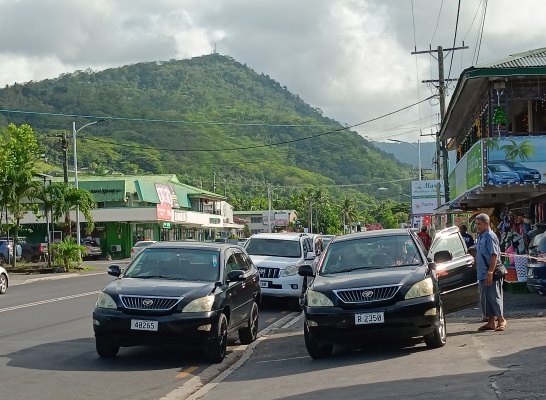
At the end of my street in Apia, Samoa rises a verdant hill called Mount Vaea. Near its top, a little way down a ridge on the other side, lies the grave of Robert Louis Stevenson.
You may wonder: why is the author of, among many other works, Treasure Island, A Child’s Garden of Verses, Kidnapped, and The Strange Case of Dr. Jekyll and Mr. Hyde buried on this very remote South Pacific island? Was it once a British territory? The answer is no; not really. During Stevenson’s time here in the 1890s, efforts to colonize Samoa were mostly a contest between the United States and Germany. Regardless, it was Stevenson’s striking individuality, not his British-ness (actually he was Scottish), that brought him here.
Here’s what happened. After a very productive writing period in southeast England in the 1880s which resulted in the publication of the above-mentioned books, Stevenson’s health was once again crashing. A lifelong sufferer of pulmonary disease, he and his American wife Fanny decamped for the USA in search of lung-friendly climes. The initial plan was Colorado, but that got nixed in favor of the Adirondacks and then Fanny’s adopted hometown of San Francisco. Then, in 1888, they chartered a yacht called the Casco and headed out into the wide blue Pacific, and never really looked back. Lifelong health challenges certainly played a role, but lifelong wanderlust played a bigger one.
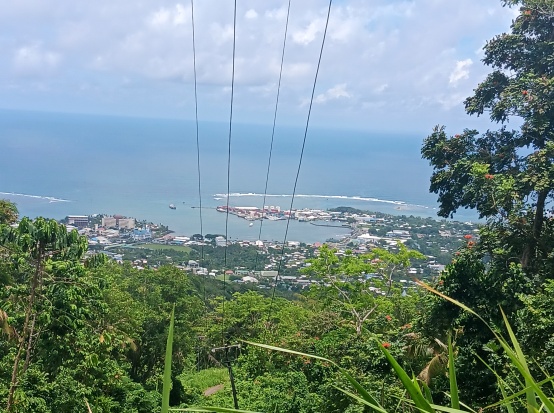
They tooled around the vast ocean for a few years, spending significant time in Hawaii, the Marquesas, the Tuamotus, Tahiti, the Gilberts, and New Zealand, among other places. In a particularly fascinating section of his engaging account, In the South Seas, published posthumously in 1896, Stevenson describes the period when he and Fanny got permission from Tembinok’, the tyrant-king of the tiny Gilbertine atoll of Apemama, to live among them for a number of months.
At the tail-end of 1889, the wanderers decided to make Samoa their home. They acquired acreage at a place called Vailima, in a verdant valley a couple miles inland from Apia’s harbor, about an hour’s walk from my apartment. There they built the islands’ first two-story house, Fanny focused on running the estate, and Robert immersed himself in Samoan culture and—
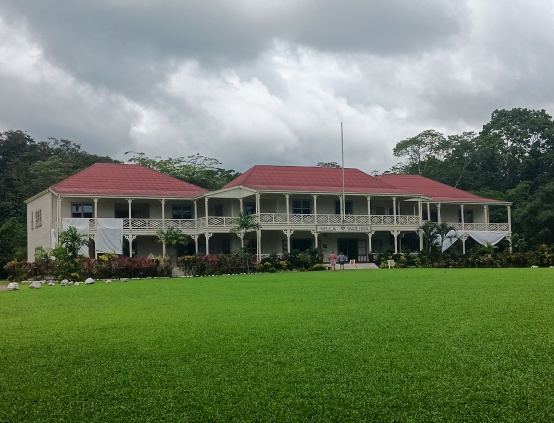
Wait a minute. “And, and.” What did Robert do? Why is it that he had to do anything? That’s pretty much what I want to talk about here. Why is it my—and perhaps your—knee-jerk reaction, to want to qualify and quantify what he did?
So far I’ve explained a bit of the “how” of Stevenson getting to Samoa. Equally but probably more interesting is the “why”. I touched on one possible reason—wanderlust—but looking at it in this way would be taking a very simplistic view of this very complex thing called life, and reducing it to a mere cliché.
The truth was that Robert was, and always had been, Robert. He was not a normal person. Born into a family of engineers and lighthouse designers, early on he realized that, despite the enormous pressure to “succeed”, none of that was for him. He took a rather different view of life and, early on, noticed that life was for living. A groovy window into his mindset can be had by reading a 3,500-word essay he wrote in 1877, at the tender age of 27, very tongue-in-cheekily entitled An Apology for Idlers. He wrote it about two years before publishing his groundbreaking travelogue, Travels With a Donkey in the Cévenees, in which he is one of the first writers to depict hiking and camping as something you could actually do for fun.
Here’s the opening of An Apology for Idlers:
“Just now, when every one is bound, under pain of a decree in absence convicting them of lèse-respectability, to enter on some lucrative profession, and labour therein with something not far short of enthusiasm, a cry from the opposite party who are content when they have enough, and like to look on and enjoy in the meanwhile, savours a little of bravado and gasconade. And yet this should not be. Idleness so called, which does not consist in doing nothing, but in doing a great deal not recognised in the dogmatic formularies of the ruling class, has as good a right to state its position as industry itself.”
Continuing, Stevenson submits he wasn’t claiming there was nothing to be said in favor of diligence—rather, that there was NOT nothing to be said AGAINST it.
“Extreme busyness, whether at school or college, kirk or market, is a symptom of deficient vitality…There is a sort of dead-alive, hackneyed people about, who are scarcely conscious of living except in the exercise of some conventional occupation…This does not appeal to me as being Success in Life…”
He goes on:
“Perpetual devotion to what a man calls his business, is only to be sustained by perpetual neglect of many other things.”
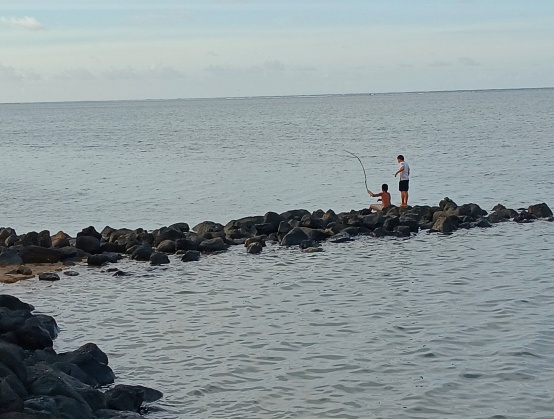
Perpetual neglect of many other things? Such as? Stevenson had an answer:
“There is no duty we so much underrate as the duty of being happy.”
In Stevenson’s words, “A happy man or woman is a better thing to find than a five-pound note.” And he was talking about five pounds in circa-1877 sterling, mind you!
“He or she is a radiating focus of goodwill; and their entrance into a room is as though another candle had been lighted. We need not care whether they could prove the forty-seventh proposition; they do a better thing than that, they practically demonstrate the great Theorem of the Liveableness of Life.”
Consequently, Stevenson believed that if a person could not be happy without remaining idle, then idle he or she should remain. Sure, realities of life such as hunger and the need for shelter kept such habits in check, but nonetheless he stood by this as a moral truth. If he were to write this essay today, he might also point out that our “extreme busyness” has resulted in the irredeemable destruction of our planet. And he might note that the “idle” person, in choosing to stop, is actually saving the world.
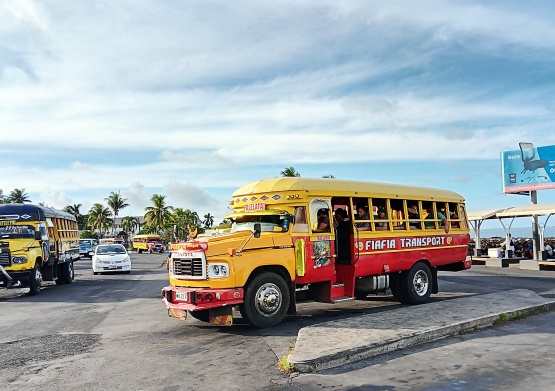
Anyway, back to the story of the Stevensons in Samoa: Fanny focused on running the estate, and Robert immersed himself in Samoan life and culture, cared about Samoa deeply, and became quite the investigative reporter, expertly embedding to produce the only detailed eyewitness account of the time: A Footnote to History: Eight Years of Trouble in Samoa.
In all, Stevenson wrote more than 700,000 more words during his idleness in Vailima. And he shifted his fiction in an exciting new direction, moving away from romance and adolescent adventure into deft literary realism. His gritty South Seas tales are testaments to this, as are Catriona (an adult sequel to Kidnapped), and Weir of Hermiston (which, alas, went unfinished).
It was a December day in 1894 in Vailima, very close to their fifth anniversary in Samoa, when Robert took a break from working on Weir and various other endeavors, and was talking to Fanny while opening a bottle of wine. Or maybe he was making mayonnaise.
He paused. “What’s that?” he exclaimed. “Does my face look strange?”
Then he collapsed, probably of a brain hemorrhage. He was 44.
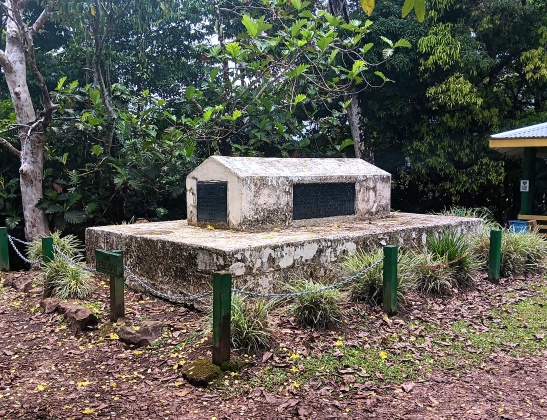
Not a bad way to go out, if you ask me: in a verdant valley below Mount Vaea. And I get the feeling that although he was young, and probably felt he had so much more he wanted to do, he went out with a satisfied mind.
Satisfied because he understood the truth. He understood the assignment: that all of us are given only one job to do, and that job is to live.
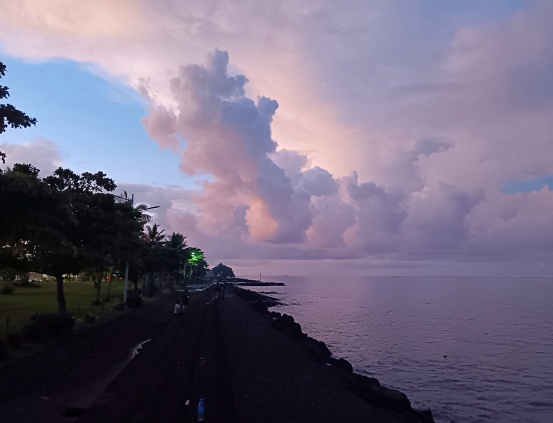
“The world is so full of a number of things, I’m sure we should all be as happy as kings.”
“Happy thought, from A Child’s Garden of Verses by Robert Louis Stevenson
The Vine Outside My Door
April 9, 2025
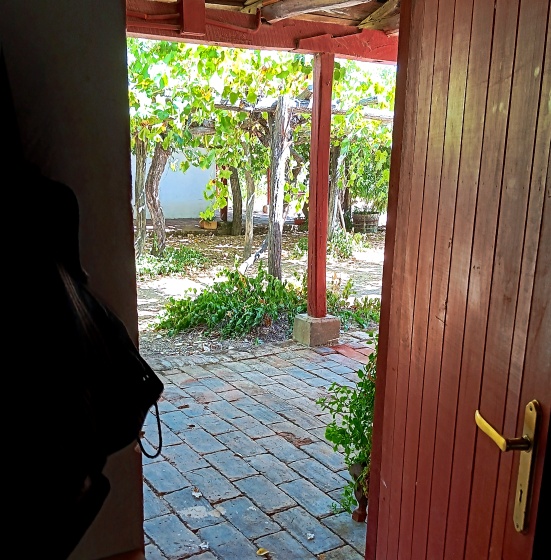
One day in 1835, in a remote corner of Chile’s Maule Valley, someone selected two grapevines. Who this person was has been lost to time. Why they did it is a little bit less of a mystery. As for which vines they chose, only recently have researchers figured it out.
Each of these vines had proven its grit. Each was brought by the Spanish in the 1500s, and had adapted and thrived in a dry and often hostile environment, with little or no irrigation, where other grapevines could not establish themselves.
One was Muscat of Alexandria, one of the oldest genetically unmodified vines still in existence. Its big white grapes evolved in the hot climates of North Africa, where for millennia they had been appreciated not just for wine, but also as table grapes used for eating and raisins.
The other was Listán Prieto. Deep-purple in color and smaller, it has long been extinct in its believed birthplace of Castillo-La Mancha, Spain. During the colonial era it made its way, via the Canary Islands, to and throughout the Americas, and particularly loved its new home of Chile, where it flourished and became known as País.
On that day in 1835, at the base of an enigmatic hill called Caliboro, someone selected a País vine (or was it a Muscat?) and, before its flowers opened, removed the stamens. Then they selected a Muscat vine (or was it a País?), collected pollen from it, and brushed the pollen onto the stigmas of the emasculated flowers. They covered the flowers to prevent cross-pollination and protect the developing fruit, and when it was ready, collected and planted the seeds.
One of the seedlings was placed in the center of a very old house (which back then was a fairly new house), where it became part of the parrón, or central vine-trellised courtyard.
Time went by.
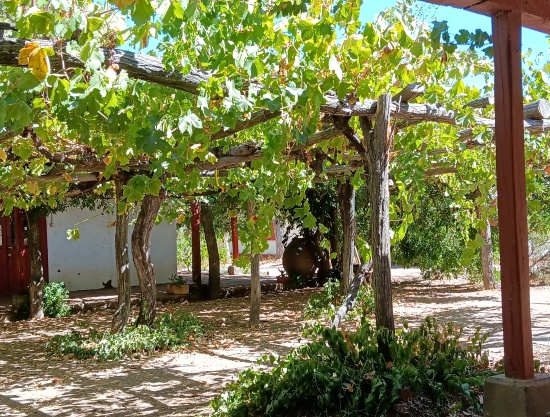
Generation after generation grew up, lived, and died around this vine. Their laughter and tears, their songs and cooking fires, their very breaths became interred in its thickening, twisting trunk, along with the energy of the river, the sun, the hill, and the quartz-filled earth. Countless feasts and gatherings occurred beneath its leaves, where children ran and played (and still do) while grownups sipped its wine and everyone snacked on its large, white, thick-skinned grapes.

Through good times, horrible times, and all the times in between, the vine remained a silent and central fixture. Sometimes it was cared for; other times, for long stretches, it undoubtedly was not. During these periods it had to care for itself, ward off pests, and make do with little water.
Before long, although people knew the vine well, no one knew about its unique identity. No one knew it was one of the earliest original vines of Chile—a born in Chile vine, born of two different parent strains which were among the oldest heritage strains brought over by the Spanish.
“We thought it was Torontel,” my boss Javier, who is a descendant of the original family, told Litoral Press this past October. “And we were vinifying it for the sweet wine we make.”
Javier and others remained curious, however. Three years ago they brought it to the attention of researchers at the INIA, Chile’s Institute for Agricultural Research, and this past year they completed PCR analysis to identify its unique-in-the-world genetics. Even more recently, they completed ring analysis of the trunk and determined its age.
There are 189 rings, going on 190.
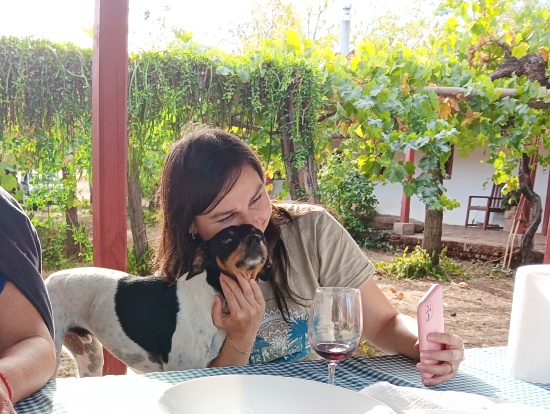
Last year’s harvest brought 140 kilograms of big white grapes, which were vinified and presented in November at the 2024 Wine Culture Festival in the nearby town of San Javier. No longer is this vine nameless. It is now registered as NN 202 de Caliboro, and hailed as a valuable contribution to Chile’s oenological heritage, not to mention its future. With its promising sensory notes of pineapple, apricot, and citrus, Caliboro is remarkably different from the eight European varieties dominating the region and the world. It is a rustic and provenly stubborn vine, pest-resistant, built to compete in a climate change scenario—clearly so, since it has managed for so long already! As such, the winery here currently has more than 2,000 cuttings in its nurseries, and is getting ready to outplant them.
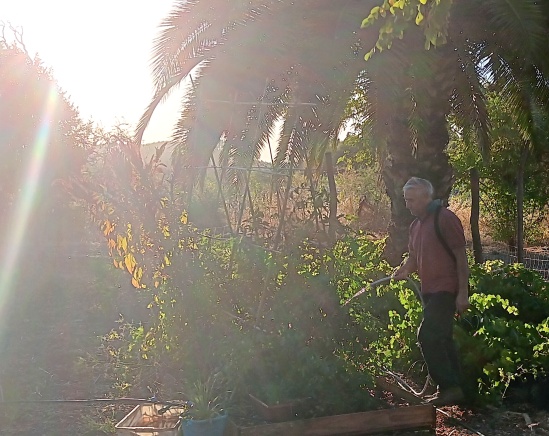
In February we harvested the 2025 Caliboro, crushing it by hand on a warm Sunday afternoon in the shade of the parrón. We got about 140 kilograms again.
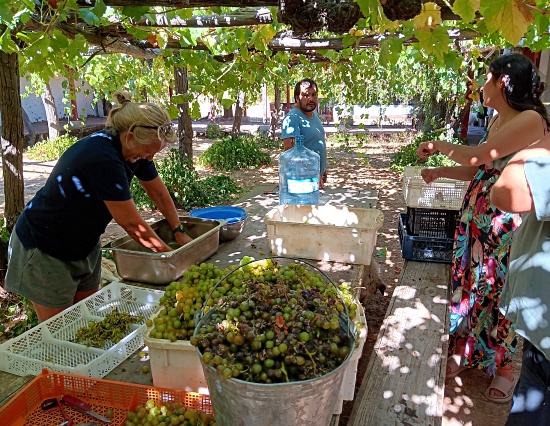
Last week, the wine was ready.
“This is a special moment,” Cecy said, in the slanting afternoon sunlight of her laboratory, where we filled and corked the specially-labeled bottles. We retrieved some wine glasses from the breakroom next door, and we all savored the moment.
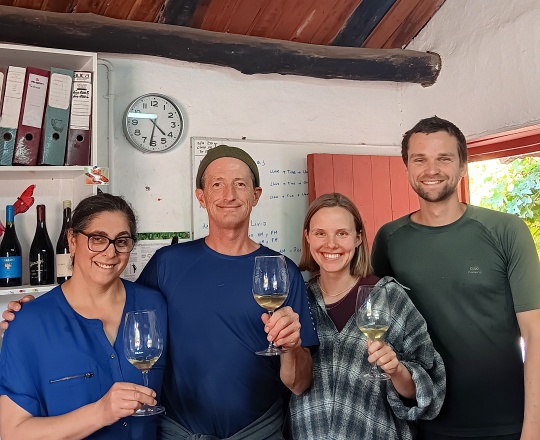
Indeed, this grape has potential.
That night, once again, I laid my head down to sleep in my ancient room, not thirty feet from this remarkable vine, as I have done now for three winemaking seasons. I’ve always felt a strong pull of attraction to this place, and this vine. There’s something here that clicked with my soul from the moment I first came, and kept pulling me back. It feels terrific to know that I have now added the carbon of my own breaths to multiple rings of its trunk, added and overlaid it onto those of so many others. In this trunk, our lives have joined together.
And all our lives join together, to compose what is still but a brief moment in time.
To me, this vine speaks silently. “Life goes on,” it says. “It is important to continue. Because we are going to continue, anyway.”
“And life is not you,” it reminds me. “Life is outside of you. Because of this, you have to go to it.”
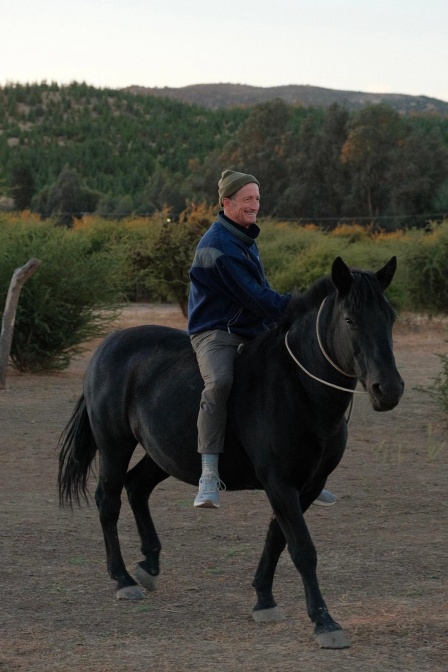
And so, I roam. I continue this process of going towards life, learning, experiencing, scratching the surface. Occasionally places stick, and I find myself coming back to them over and over. They call and speak, silently. But then, inevitably, it becomes time to turn away and go. And I do so without moving the fire; keeping these people and these places inside of me, where they continue to burn and smolder in the center of my chest.
So many memorable people have popped up along the way, who I got to somehow know and write about, these past eight and a half years! There was Ivy Baldwin, ace tightrope walker of the early 1900s. Tsianina a.k.a. Princess Redfeather, singing opera. Janet Bonnema defiantly entering the in-construction Eisenhower Tunnels to collect her data. Empress Sisi of Austria-Hungary. My friend Tizi Hodson, flying single-engine across the north Atlantic. My life partner, Dewey. A guy named Ty, who I met on a Colorado trail, telling me the emotional story of when he had to kill the coyote.
There was an elk. There were monarch butterflies. A cat named FredSmith.
Now it is time to move on, in the lyrics of Weyes Blood, with “Hearts aglow, we don’t know where we’re going.” Keeping in mind that love is a verb. It is something you do.
Moving forward, entrusting. Hopeful and hopeless at the same time, but not giving up and especially not giving up on self. With no cause, no crusade; not making things worse but not necessarily trying to make things better either, because that can backfire. Trying with a whole heart. Experiencing. Being here.
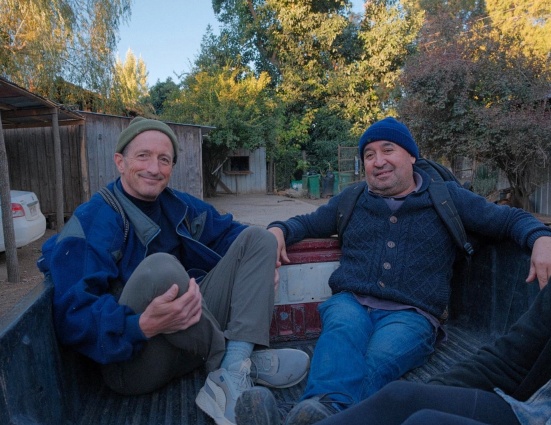
Bricklaid
March 21, 2025
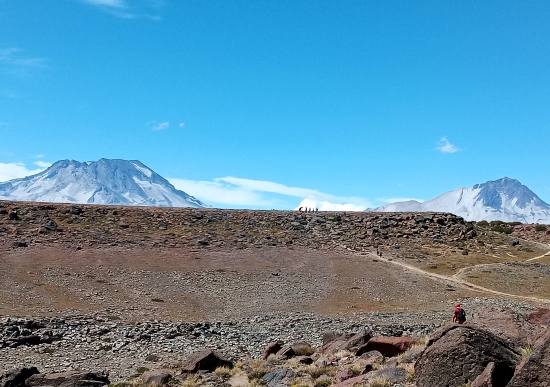
On the twelfth kilometer of a hike in the Maule Andes, you come over a rise and it is difficult not to gasp and go, “Wow, wow, wow.” Two gigantic volcanoes, which have kept themselves hidden until this very moment, rise in close-up beyond a startlingly flat plateau. It’s a dramatic scene, to say the least!
On the left is venerable Descabezado Grande—Big Headless—majestic and relaxed in her broad slanted profile and wide crater. Jutting up on the right is her eager young granddaughter, Quizapú. Together they make an iconic and thrilling sight.
And what’s up with the freaky stone mesa in the foreground? It looks like something out of Star Wars!
It looks like an alien landing strip!
So much so, that you can forgive the many people who like to believe that’s exactly what it is, or was.
This is El Enladrillado, “The Bricklaid”, bucket-list destination for UFO enthusiasts of the world.
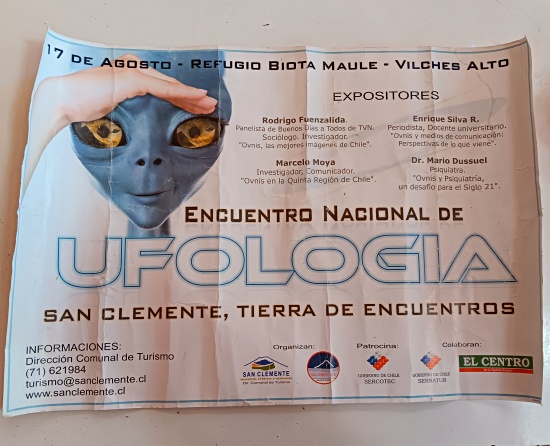
“Ufologia” is big in Chile, and the surrounding area of the San Clemente Commune is one of the world’s hotspots for OVNI (objeto volador no indentificado—unidentified flying object) encounters. Hundreds of sightings have been reported in recent decades; lots of bright lights doing impossible aerial maneuvers, humanoid figures levitating above trees, and such.
These sightings really ramped up after El Enladrillado became more publicly known in the 1970s. Of course, local people have long been aware of this curious basalt landform. Triangular in shape and about five acres in area, it sits above the treeline at an elevation of about 7,500 feet, in the pre-cordillera mountains west of the Divide. However, it wasn’t until a lot more people found out about it, and began coming here, that the UFO stuff really started to happen.

El Enladrillado certainly is an unusual formation: fractured volcanic stone resembling rectangularly-fashioned blocks fitted together like brickwork. Over 220 units in all, they appear as orderly tiles, sterile and unnatural amidst the spectacular wild landscape. It’s easy to see how someone would think this had to be man-made, perhaps alien-assisted; installed eons ago during some ancient unknown civilization to create a sacred place for extraterrestrial visitors to land. Given the beauty and energy of the surroundings, it’s a great location for our fertile imaginations.
I found myself running across the tiles, needing to get to the edge and take in the full view of an ocean of mighty mountains, and the Rio Claro, which flowed below through a seemingly limitless wilderness. I sat down on the mesa edge and snapped a bunch of pictures.
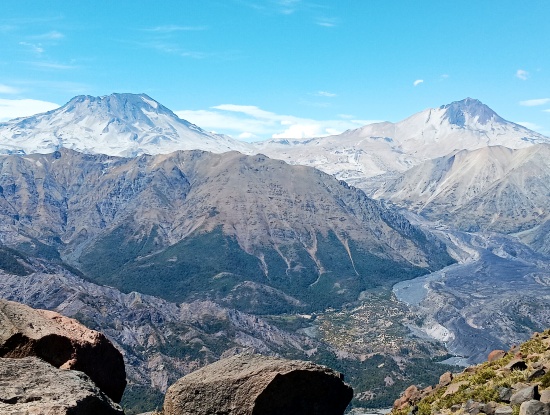
Then I began to feel incredibly tired, so I laid down on a sun-warmed brick and slept for an hour. As such, I can attest that this place has a distinct energy. For me, it’s a calm energy. Of course, this could have had something to do with my long workdays at the winery-qua-cider house eighty miles away, from which I was getting a much-welcomed respite. Perhaps it also had to do with me finally meeting my Andes. Finally! I had greeted Descabezado Grande and Quizapú up close, after admiring them for years from a distance, from my perch on Caliboro Hill above the winery.
I could rest, now. When I came to, I rolled over on the brick and studied it up close. This piece of pyroclastic flow, which settled and cooled here to give me this privileged view, had been deposited probably some time in the last million or two years, putting it in the late Pleistocene. Deposited and cooled, it had been fractured and worn away by actions of ice over eons.
This brick was totally amazing. I felt no urge to attribute it to something unnatural, man-made, invisible wizard-hewn, or otherworldly. Rather it was the natural, magical Earth just being itself. There is nothing more amazing than reality, nothing more fantastic than the story—the real one—that presents itself in front of us every day.
I gazed across the plunging Rio Claro valley to Volcán Quizapú.
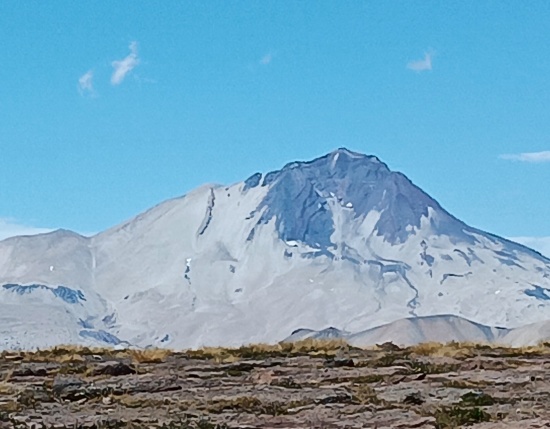
Younger, much younger than the strange stone plateau on which I was brick-laying, is Quizapú. To me she is the star of this story. Only in the most recent epoch, the Holocene, did her gorgeous cone arise—sometime only in the last 11,000 years or so! A tiny blip in time!
Strictly speaking, she’s a secondary chimney of Descabezado, and together they are responsible for some of the biggest eruptions registered in South America since the Spanish arrived. Her current crater, hidden from view on the north flank, burst out on November 26, 1846.
This was when some arrieros, or backcountry herdsmen, were camping about the same distance from her as where I was brick-laying. Late that afternoon, they heard a huge explosion and saw a cloud of ash. Night fell and was full of continuous roar, blue flames, thunder, lightning, and choking sulfurous gas that sent them scurrying. Of course, they had to come back later and look for their animals. When they did, they encountered a hot lava field. And a new crater-mound.
Eighty-six years and fourteen eruptions later (including a really big one in 1932 that was likely the strongest eruption on the continent that century), we have the beautiful brand-new mountain we see today, soaring over the strange, bricklaid plateau that predates it by an unfathomably long expanse of time.
Which is, itself, also only a blip in time.
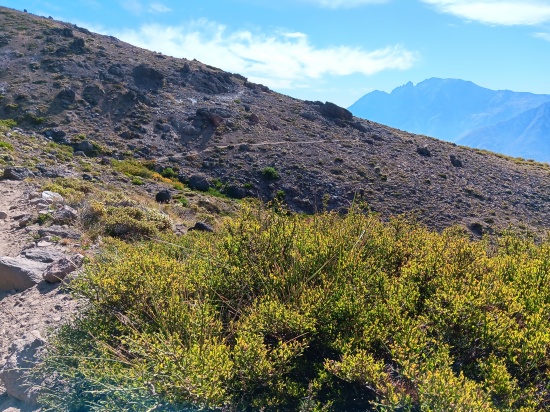
Cider House
March 10, 2025
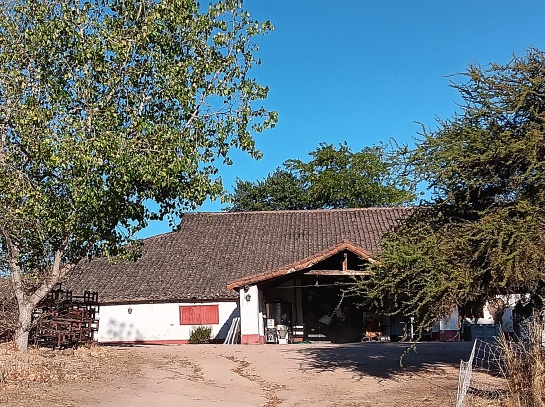
“Pete! Come watch the first test!” my foreman called to me, here at the 150-year-old winery in Chile where I am working my third season.
I paused my barrel washing operation out on the back dock and came around the corner just in time to see Javier, the General Manager, toss a shovelful of apples into the inlet hopper of our new crushing machine. The apples fell in, and then immediately blasted back out in a thousand pieces to rain—actually, snow—down on us.
Hmmm, we all thought, our hands on our chins.
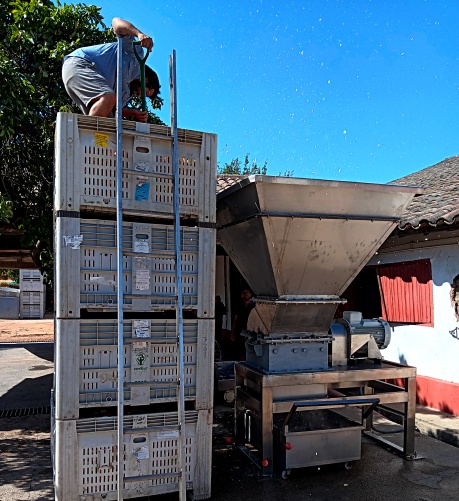
Wait a minute, you might say. Apples in a winery? What’s going on?
“We’re making cider this year,” Javier texted me, late last year when I wrote to confirm my dates. “For a Brazilian client. Muuuuchos kilogramos.”
This sounded great to me. A new process to learn, in the same gorgeous late-summer-turning-to-Chilean autumn, at the same remote, historic bodega at the base of Caliboro Hill. With the same good-natured, tightly knit team. The same sunsets, the same stars, the same shimmering Andes—except this time, the graceful adobe structure would be filled not with the sweet smell of fermenting grapes, but rather with crisp apples turning to hard cider.
Fortunately, the “it’s snowing apples” incident was mostly due to the crusher’s motor being wired backwards. Once that was fixed, however, we still had quite a bit of fine-tuning to go through in order to move our first (of five) large-scale batches of locally-grown organic apples through the facility.
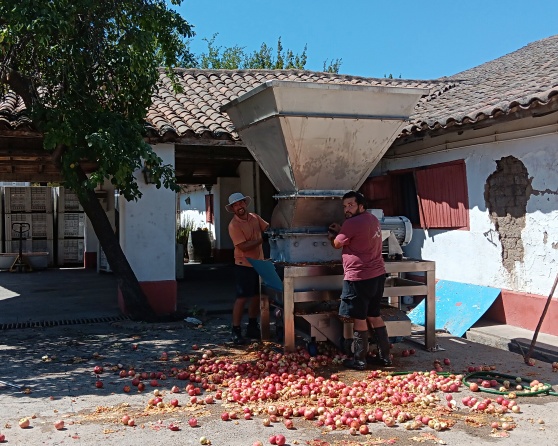
It’s now two weeks later and it’s been apples, apples everywhere. Many lessons have been learned. Some lessons have been obvious, such as never, ever spill a bin of apples onto the ground from the forklift because that means thousands of apples will need to be picked up, one by one, by hand.
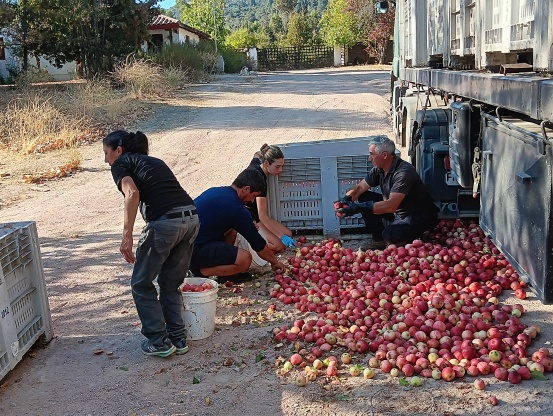
Other lessons were not so obvious, such as: how high to fill a tank with fresh apple slurry? We filled our first 17,000-liter tank on a Thursday, and on Saturday morning I was greeted by hundreds of pounds of apple goo that had swollen up overnight through the tank’s top opening and run down the sides to pile up on the floor.
For your information, two-day old crushed, aerobically fermented apples have the exact same hue and texture (but thankfully not the aroma) of blown chunks—of the human variety.
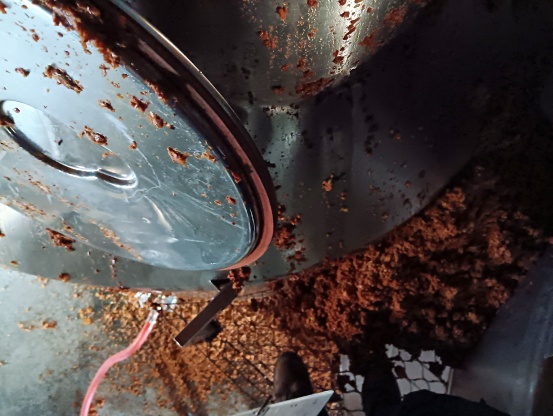
How does it taste? Delicious, of course! At least for the first few days. My favorite day of the fermentation is day four; by then the juice is still very sweet but has a little bit of fizz and kick to it. After day nine or ten it gets quite bitter and pulpy, with of course even more of a kick, one that I have no business experiencing while climbing ladders and operating heavy equipment.
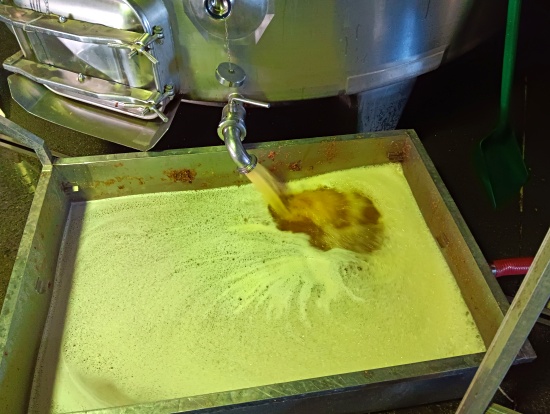
It has taken a lot of effort, with some long days in which we’ve continued working while the late summer sun set beyond the poplars. As of now, the first three tanker trucks of fermented apple sludge are making their way 1,700 miles, across the Andes and Argentina, to Caxias do Sul in southern Brazil. There it will be further processed into vinegar, bottled, and shipped around the world. In the next several years, should you go to Whole Foods and purchase a bottle of high-end, organic apple cider vinegar, it’s quite possible that I will have had something to do with it!
Literally. A few afternoons ago, I had to go inside some of the tanks in order to shovel out stubborn apple sludge that had settled on the bottoms and failed to fall out and get pumped through our fat “anaconda” hose out to the waiting tanker truck.
As I schlepped monochromatic brown goop with a plastic shovel (goop which was by now the color and consistency of another bodily substance which we definitely do not need to talk about), feeling a little high on the fermentation fumes still present inside the tank, I thought: I miss the grapes. Not because the grapes are any easier to process—in fact, they are a lot more difficult, and require entering each and every tank to shovel out the skins for pressing. The grapes get everywhere, and they’re enormously messy and tedious, but they are also gorgeously colorful: radiant blood reds, heart-swooning violets. And of course they smell amazing.
“I miss the grapes,” I said to Cecey, our laboratorian, later, as she crouched in front of a graduated cylinder filled with tan cider to measure its density.
“Me too,” she said. “So vibrant, so beautiful!”
We both smiled.
“Come,” she said, standing up. “Help me replace the telas.”
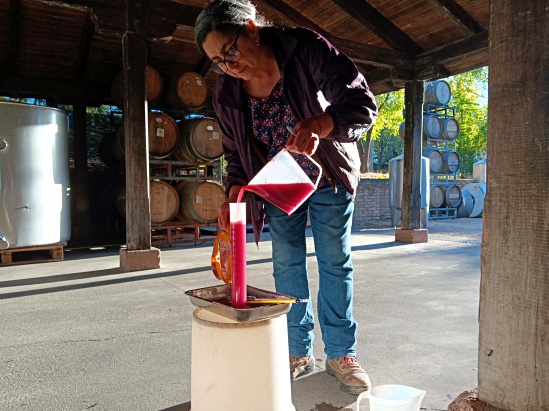
She led me to our open-air, low bay area, where seven square vats of crushed Grenache, and four of Pais—Chile’s iconic, old-school grape—were slowly turning into rich red wine. Yes! This dear old bodega is mostly about apples this season, but still making some wine, like it has done for more than a hundred and fifty years.
Mmmm, I thought, inhaling the aromas, as Cecey and I lifted the white silky telas (cloths) and draped them over the vats to cover them, thus allowing the vats to breathe while keeping the flies off.
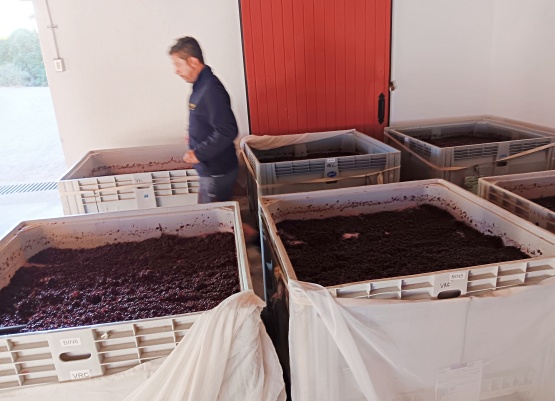
I hadn’t been this enthusiastic a week previously when, early in the morning in my room, while donning my steel-toed shoes in preparation for another day of cider processing, I received a text from Javier:
I need you to join the harvest today.
“Ugh,” I immediately thought, as I removed my shoes and slid into lighter-weight hiking boots, and reached for my industrial-grade grape cutting scissors that sat on a window sill.
It’s always like this for me in the morning prior to going to harvest. The idea is a bit much to deal with: of a full day spent trudging through tall grass, reaching through bushy old vines to surgically remove the bunches of manna, tossing them into a white plastic hand-crate, hefting the crate and trudging all the way back to the truck to leave it and get another, all under an eventually very hot sun.
Then there’s the aspect of the old-school field guys I’d be working with, whom have been doing this their whole lives, whom can get a bit impatient and irascible with someone like me who can’t pick as fast as they do, or always know which row I should be working on, or understand their rapid-fire, thickly-accented yelling of where I need to go next.
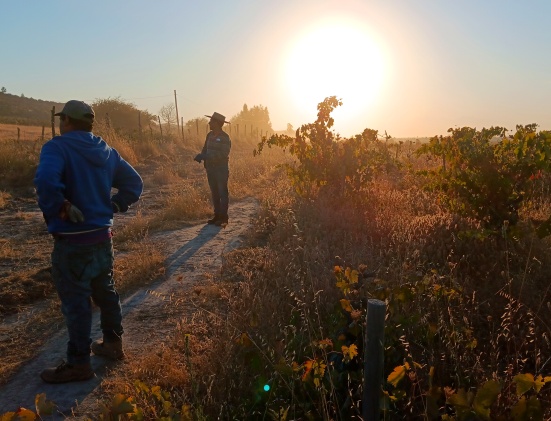
However, I always start to feel better as soon as I get out into the sparkling morning and hop up onto the flatbed trailer with other teammates, off to go join the men out in the fields. So nice, to get a reprieve from the bodega! And to be outdoors, in the fresh air amid the grape fields, beneath the Mediterranean-esque rise of Caliboro Hill, with lofty Andes in the distance.
The first few crates of grapes for me are always a struggle. Then, as the morning progresses and the sun grows warmer, I get into a rhythm. It gets easier to find the grape bunches and locate the best places to snip them. My crates fill up quicker, one after another, and the hours go by. When it’s time to go, I almost don’t want to. I want to keep harvesting! Especially if there are still grapes out there that we need to go and get.
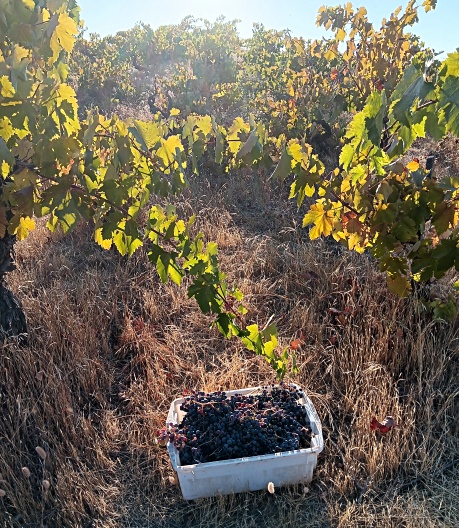
But of course, I am always grateful when we are done and climbing back onto the truck, exhausted, dirty, sweaty, ready be conveyed back to the bodega for much-needed food, hydration, and rest.
This day was no exception. In fact, it was something more.
“It is an honor, really” I said to my friend Felipe, a young Chilean sommelier, who was standing next to me on the trailer, who like me is here for the peak months to live and to learn.
We gazed at the rows of irregular, bushy, twisted, knobby vines growing out of the tall brown grass: vines that are at least a hundred years old. Maybe even two hundred years old.
“It is an honor and a privilege,” I continued, “To get to harvest the old País. To be a part of something so central to Chile’s—what is the word for it? In English, we would say, ‘heritage’.”
“Herencia,” Felipe said, nodding.
“It’s true,” he added, a moment later. “This is Chile’s heritage, and it is vanishing. So many of us are not even aware of it. Millions of people live in Santiago, who have never been outside of Santiago, and who have only a vague, romantic notion of the countryside and this way of life. They have no personal experience with it.”
By now it was mid-afternoon and the sun was hot and high. Near to us, Don Miguel crouched in the thick shade of an old País vine, wearing his trademark wide-brimmed hat. He was chatting with Don Leo, our tractor driver, who was finishing his cigarette before we’d go. Miguel would not be joining us on the flatbed, however. His horse was tied to a nearby tree.
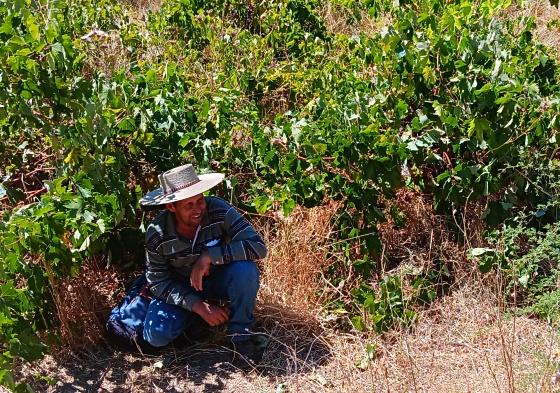
“These men, too, are our heritage,” Felipe said to me, more quietly, as Don Miguel broke into a laugh and said something to Don Leo that I didn’t understand.
“They, and their huaso way of life. Like the País, these guys are vanishing. They can be prickly, hypermasculine, difficult to be around sometimes. But it is an honor and a privilege, to get to work alongside them.”
The Seahorse
February 9, 2025
Imagine it’s the 1970s in Chile and you are imprisoned and tortured on an island. Blindfolded and naked, you are hung upside-down and receive electric shocks, beatings, and humiliation daily. The horror, pain, and fear barely ebb as you are thrown back into a pitch-dark cell, where you are deprived of food and water and await more such treatments the following day. But the terror rises to new heights when they come to pull you from the dark, throw a blanket over your head, and march you back to the lavatories of, say, a former school for naval sailors, where you will be tortured again.
The only thing you can see, the only daylight you have seen for weeks, for months, is the faintly-illuminated floor passing beneath your feet. Then it appears: a bronze grate in the bathroom floor drain, fashioned in the shape of a seahorse.
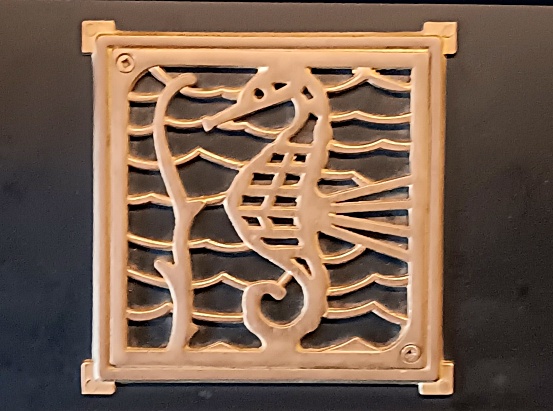
How would it feel, to glimpse that seahorse?
Seahorses and Chile go way back of course, as does pretty much anything to do with the sea. When a country is 2,700 miles long and only about 112 miles wide, a lot has to do with the sea. Sea creatures are part of everyday life, and naturally have long found their way into folklore and mythology.
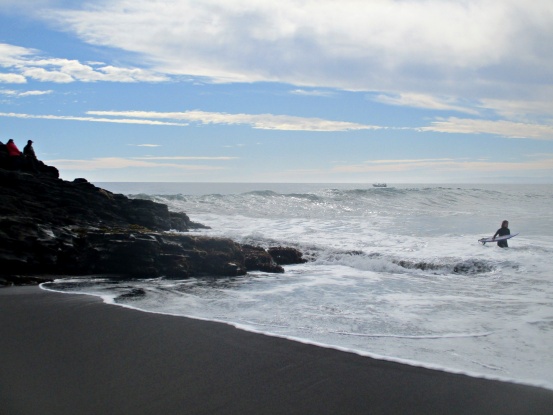
Perhaps nowhere is this more prevalent then in the Chiloé archipelago, in the moody, drenched, temperate rain-forested mid-south. Here a distinct mythology developed separate from the mainland, a potent mix of two indigenous religions injected with Spanish legends and superstitions compliments of conquistadors who arrived in the 1560s. For hundreds of years after that, Chiloé carried on in near isolation, as the mainland Mapuche expelled the Spanish to regions farther north and the folklore of the archipelago seasoned and ripened on its own.
A good example is El Calueche, a phantom ship that is believed to be a living being. In service to the king of the seas (whose name is Millalobo), it sails for eternity, clearing the sea of dead drowned bodies which are delivered to it by three members of the royal family. On board, the corpses are brought back to life to man the ship, in zombie form, under the watch and care of supernatural beings.
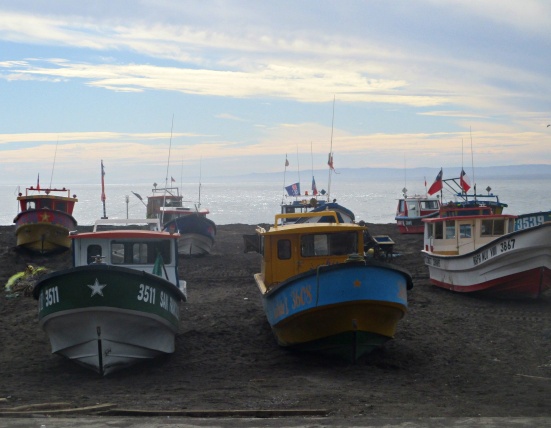
The ship is said to be shining white, with three masts and five sails. Lights blaze in its windows and the sounds of music and revelry can be heard, but it disappears when anyone tries to go near it (it is believed that it can travel underwater). In addition to the crew and managers, brujos—which are warlocks or sorcerers—often come on board to participate in the festivities.
Here’s where the seahorses come in. For reasons unknown to mortals, the brujos are forbidden to join the ship by donning their flying vests or changing into birds, which normally they can readily do. Instead they must go to the shore a few minutes before midnight carrying a sargassum seaweed bridle, and make four special whistles to summon one of their personal seahorses. When their steed arrives, a brujo will carefully and gently establish contact before restraining it with the seaweed rope, and then climb on its back to be conveyed to the ship.
These seahorses are invisible to normal eyes, but anyone can detect their presence by observing the movements in the water among shoreline rocks. To the brujos, they are dark yellowish-green in color, resulting from their diet of seaweed. They live short lives of only four years, after which they turn to gelatin and dissolve. This means that brujos must regularly obtain new seahorses, which they presumably do while El Calueche is traveling underwater. On encountering a subterranean flock while sailing with the ship, a brujo can brand his personal mark on a new steed of his choice, and thus place it devotionally into his service.
Sure, this is an uncommon myth specific to Chiloé. But the seahorse itself, as a symbol, as a motif, is and was hardly uncommon throughout Chile.
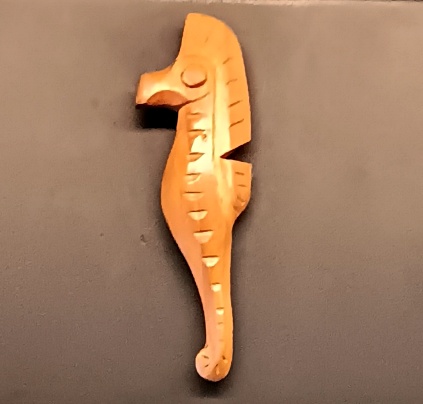
In fact, if you were one of 3,200 people who disappeared during the Pinochet dictatorship, or one of tens of thousands more who were detained and tortured, but survived, in one of the approximately one thousand torture centers that were set up, up and down the country, it is quite possible that the seahorse in the bronze drain plate was something you encountered as part of your experience.
How would it have felt? How would you have reacted, to see this image appear before you as part of your brief, sole flash of daylight?
Would the seahorse look like a monster, coming to usher in imminent horrors? Would it bring a new rush of queasiness, fear, and panic?
Or would it bring something else?
Curiously, the drain plate seahorse took on an entirely different, more positive significance for many of the sufferers. Instead of being seen as guarding the gates of hell, it rather became a symbol of resilience. Many detainees later reported that glimpsing that golden flash of the seahorse in the drain grate was the only nice thing they experienced, and it made them forget, just for a tiny little bit, what they were about to go through. It gave them a small ray of hope.
Sometimes light could be seen through the portal beyond the seahorse: light leading to the outside, reminding them that there was an outside world, another place where the evils and the rage could fade, where a person could be cleansed of suffering. The long tunnel that began at the seahorse, at some point, undoubtedly reached the freedom that everyone longed for.
In the flash of the moment, in your mind, you could climb on the seahorse’s back, and be conveyed to a different place: To a new life, or if not that, to an afterlife free from pain.
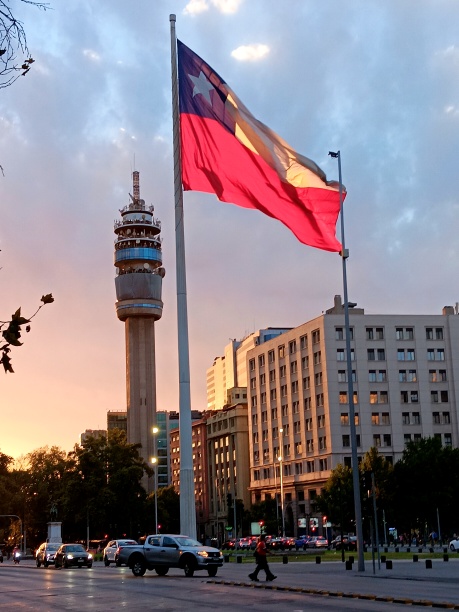
Lotería for a New Year
January 10, 2025
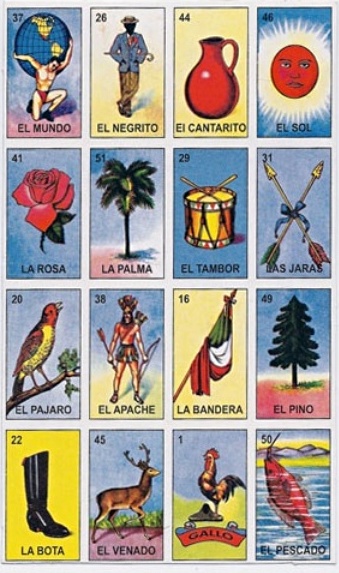
The Mexican Lottery, as you may know (I didn’t, until now) is a cherished bingo-like game that goes back hundreds of years. In it, each player chooses a uniquely-arranged 4 x 4 board of images. Meanwhile, the Singer shuffles a deck of 54 cards and prepares to sing or call out the images.
How do you win? Get four in a row, of course! Or in a column, or on a diagonal, or in the four corners, or four in a square. Mark your spots with pinto beans or corn kernels and shout “¡Lotería!” before anyone else does, and you win! Or for a longer-form game, be the first to fill out an entire board.
It’s a game everyone can play, and it is full of feeling, nostalgia, and retro charm.
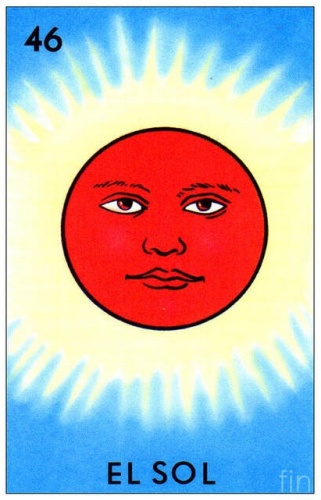
The singing is very important, and here’s where the game goes somewhere that Bingo does not. Lotería is all about being creative with words and verses, thus amping up the enthusiasm of the players. Each singer has poetic license to inject their personality and intellect, and sing out an improvised verse in clue-form to add wit and complexity to the game. For example, instead of simply calling “The Sun,” you might sing, “The coat of the poor…the Sun!”
Depending on context and setting, the singing can get very creative and topical and, of course, risqué. In this respect Mexican Lotería is much more than Bingo (although I don’t want to discount what some callers of the latter game, especially the campy-naughty variety, have been able to do with material such as “B-8”and “O-69”. I even wrote a novel about it, called The Rooster’s Hindquarters.)
Lotería arrived in Mexico in the late 1700s from Italy by way of Spain, and within the next century it became distinctly Mexican. This status was solidified in 1887 when a definitive version was published, which is known as the Don Clemente Gallo version. Originally issuing 10 boards and 80 cards per set, the company exists to this day and still owns the trademarks to the iconic images.
Don Clemente Jaques was a French businessman who bought a factory in Mexico to make all kinds of things such as corks, bottles, ammunition, and especially, packaged food for the nation’s soldiers. Naturally there was a printing division that made labels, advertisements, party supplies, and the like, and in this division the game was printed. Being on hand, it got inserted into care packages for soldiers, something for them to enjoy to pass the time.
When the soldiers brought the game home, it really took off. Over subsequent decades, Lotería became a mainstay of traveling fairs that were set up on weekends in widely-dispersed towns. Many people came to these fairs expressly to play Lotería.
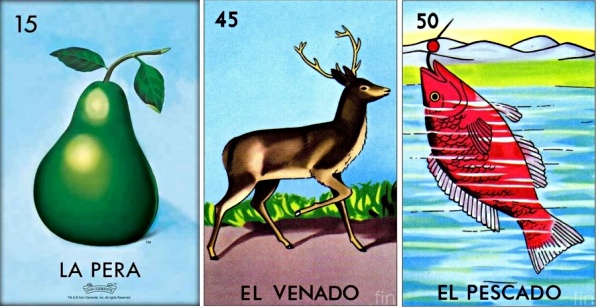
Lotería might be viewed on three levels, depending on how deep you want to go with it.
On one level, there’s all the language and word-play. For example, one might sing, “He who waits (espera), despairs!” Imbedded in this is verse is es pera, or “It’s Pear.” Or “It jumps but doesn’t see anything (no ve nada),” a play on Venado, which is Deer. Or the verse might be more riddle-like, such as, “The mute one who nonetheless died by mouth.” This would be Pescado—the caught, Dead Fish (not to be confused with pesce, which is a live fish, although there is no card for that).
On another level, each Lotería card is a window not just into Mexican culture, but into the history of popular age-old feelings in the country. The pictures tell of ideas that existed in the middle of the 1800s, and are iconic representations of objects and characters from folklore, history, and everyday life. Simple in appearance, they are far from simplistic; there is so much that meets the eye. Each comes from a deep well of story and emotion.
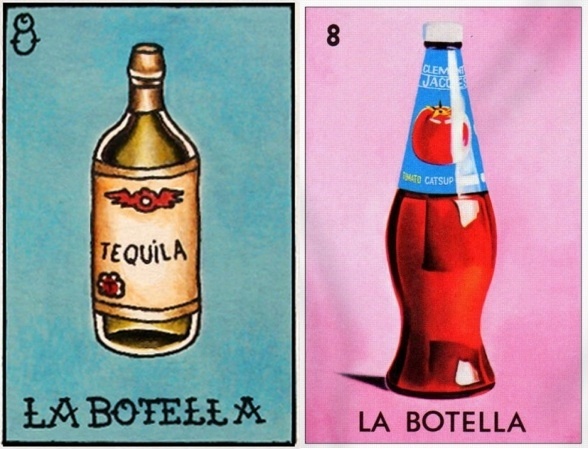
For example, for The Bottle we might naturally sing, “The tool of the drunk!” But in many early versions of the game, the bottle in question had a tomato on the label. Is there anything more Mexican than salsa? That tomato changes the story, and the song.
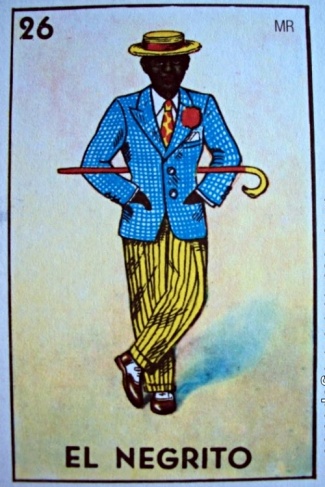
Someone could get pretty offended by El Negrito, the Little Black Guy, if they wanted to. But like all the cards, there is story and context. First off, the use of the diminutive form of El Negro is a term of endearment, and not an indicator of size. And although his clothing is very 1930s, El Negrito holds a very deep meaning that goes back an additional 100 years, one that is part and parcel to Mexican identity itself.
José Vasconcelos was a descendant of African slaves who was born circa 1820 in the state of Veracruz, or maybe it was Puebla. Though Black, he was Mexican, and a talented one at that. He had an extraordinary ability to rhyme, and he became quite known and admired for his wit and humor—a gifted wordsmith in other words, someone who embodied the spirit of Lotería.
One story has José going into a bar where the Spaniard barkeep extended his hand to shake. When they clasped hands, the Spaniard pulled both their hands to his butt and farted. Unflinching, José held his head high amid the laughter, and when he met the Spaniard a second time in a different bar, it was José who pulled hands to butt and farted—and delivered a funny impromptu rhyme about it.
Through José, El Negrito was born. By the mid-1800s every puppet show required an El Negrito character. Then came the “Pastry War”, i.e. the short-lived French invasion of the 1860s, and El Negrito became even more important: as a cheerful and talkative character who always came out proud and in a fine mood. In this way El Negrito came to represent not an outcast, but the oppressed Mexican people themselves who, despite adversity, come out proud and in a good mood—traits that have always characterized the Mexican people. In this way, El Negrito is an icon of what it means to be Mexican.
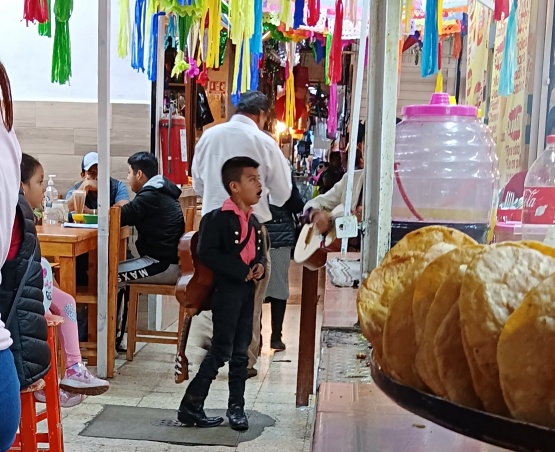
A third level of Lotería might have to do with the undeniable energy in the cards, the deep experiences of life that they resonate. Gazing at them you might think, “I’ve seen this before.” Indeed, they are archetypes. Many have analogs in the Tarot and Lenormand systems.
True, Lotería as a bingo-game is one of chance, of fate. But what if you could choose your lottery? Choose your fate? I know it sounds like a contradiction, but…
What if, as a different game, we let the cards be a fun tool—a vehicle—to choose our fate? We all do it anyway, after all, whether we want to acknowledge it or not. Every day we all choose where to direct our energy and intentions.
Here’s the game: Pick a card, any card. Actually, pick four cards, to be your Lotería hand for the coming year. Pick some good ones, ones that mean something to you!
Which ones would you pick?
Here are mine for 2025, to keep in mind and carry with me, so to speak, in my back pocket:
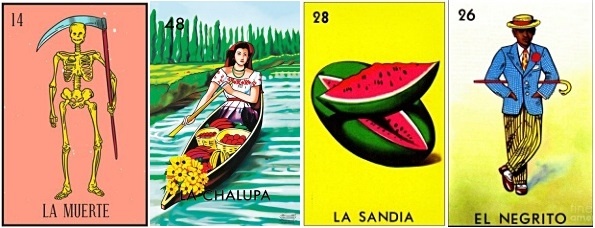
Death
This is a positive card! It’s about transformation and evolution, change of cycle, renewal. It’s about casting off the old and receiving the new. An area of life, an era, has ended. Roles are shifting.
The Chalupa
This is about feeling calm and adaptable while navigating uncertainty and transition. It’s also about self-determination, and being emotionally balanced and feeling powerful. It’s about choosing how to deal with things.
The Watermelon
This embodies love, life, and abundance! I’m thinking of Frida Kahlo’s near end-of-life masterpiece, “Viva la Vida”. Also, The Watermelon represents that, no matter how hard something seems, there is always a parallel, tender, sensitive side. Everything has a tender and sensitive side.
El Negrito
He’s my reminder to have fun, experience joy, take life with humor. Don’t be so serious all the time. Look for the good side, the bright side, the happy funny side of everything. Keep a good mood. Come out proud and always in a good mood.
Happy New Year!